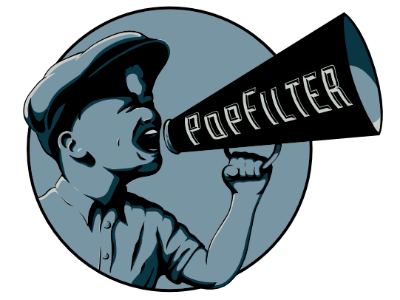Popfilter’s Foreign Flick of the Week
China’s
Kung Fu Hustle
This article is a brand new feature here at PopFilter in which I review a foreign film that I think is worth watching. Foreign films are a little too, well, foreign. The United States has such a large and profitable movie industry and suffers from militant xenophobia which causes big Hollywood films to push films made in other countries by the wayside, out of the sight of most American audiences. It’s rare when a giant multiplex features a foreign movie. That and the fact that over the years these movies have gained a reputation of being inaccessible, overly artsy, boring, filled with unattractive people and huge turn off for movie goers. That is why I picked Kung Fu Hustle for this feature article’s debut. It suffers from none of these stereotypes, and it’s a movie I have loved for many years. China’s top grossing movie from 2002-2011, it’s one part kung fu movie, one part spaghetti western and one part Looney Tunes.
This movie takes place in run down slum building called Pig Sty Alley in 1940’s rural China. One day, the slum comes under the ominous threat of the notorious Axe Gang. But some of the residents of Pig Style Alley are not just the mild mannered neighbors they seem to be. At its heart and in its title, Kung Fu Hustle is a movie that features the ballet of martial arts on film. The fight choreography of this genre is so outstandingly balanced and beautiful and is preformed by some of the world’s most disciplined entertainers. I absolutely loved the drama and visual accomplishment of each fight scene as arranged by the film’s star and director, Steven Chow. In the final battle, our hero is surrounded by the Axe Gang, and he is outnumbered 100:1. Now, this kind of scene of scene is impressive. For one thing, it requires a huge set to allow for so many fighters.
This scene needs a lot of room because in order to keep the drama level optimal, the hero has to be able to flit around a great big space in order not to become overwhelmed by so many enemies and lose the fight. This also prevents the audience from becoming lost in the action. It is a elaborate scene that is difficult to orchestrate, which is why it is usually the grand finale of any movie that features it. Kill Bill: Volume One, for example, had one of these fight scenes for its dramatic final battle when the Bride took on O-ren Ishii’s Crazy 88 at The House of Blue Leaves. Director Quentin Tarantino had Uma Thurmond flying around the room like some sort of warrior acrobat.
The hero needs to be able to karate chop his or her way across a major set piece to defeat his or her enemies. The final battle sequence in Hung Fu Hustle is so well put together, it writes the book on how to stage and execute this kind of fight scene. The film deals with the kung fu elements very well.
This movies sets itself apart because it is a kung fu comedy. It’s not a tale about a blood thirsty warrior bent on revenge; it’s closer to being slapstick. The fact that it has a comedic tone makes me buy into it. I’m sure I’m not the only one who has a problem suspending disbelief enough to accept that a man or woman that is 5ft 6 can jump over another man’s head who is 6ft tall, or fly across a room to kick an opponent in the face that happens so often in movies that feature martial arts. Puhhlease. That is so far outside of the realm of human potential it is laughable. But the fact that this movie included some absurd cartoon violence as well allowed it to set up a universe where feats of superhuman abilities are just a fact of life. As a viewer, sometimes I felt like I was watching Bugs Bunny go toe to toe with Elmer Fudd. If the slumlord can chase a guy while running past fast-moving cars, flatten herself against a billboard, peel off like a banana peel and be just fine, then the crazy things that happen in the fights scenes are more natural.
I thought of Tarantino a few times throughout the course of watching this film, mainly because like so many of his films, Kung Fu Hustle is a genre bender. It borrows a lot from the spaghetti westerns of the 1960s, as so many films in the kung fu genre do. The western elements are incorporated into in the way the film portrays life in Pig Sty Alley; it is reminiscent of the way spaghetti westerns feature the humble plains folk of the wild west. They are poor, hardworking and living in fear of a looming threat posed by a group of gangsters that threaten to poison their way of life. That would make the kung fu masters the lone gunslingers, protecting the people from harm and doing what’s right. The fight scenes might as well take place in the town square at noon with people in the town running for cover, shutting their windows and doors to the senseless violence. There are just little hints of those old westerns, and picking them out really satisfies the film nerd in me.
This is a great movie to watch with a friend, or anyone who enjoys a good kung fu fight scene and loves to laugh.
-Stephanie Rose





